See Snapshots Archive.
Snapshot for October 27, 2004.
Female job seekers have fewer opportunities than in the past
The employment rate—the ratio of employment to population—is a standard measure of labor demand that provides insight into the tautness of the labor market. Female employment rates have decreased by 1.7 percentage points since the last business cycle peak in March 2001. This is a reversal of a historically persistent, increasing trend. As Figure 1 illustrates, the recent decrease stands out when compared to female employment rates 41 months after the last eight previous business cycle peaks.1

Figure 2 offers more insight into the recent decline in the female employment rate, showing the percentage change in female-dominated industries 41 months from the business cycle peaks for the last five business cycles.2 The blue bars represent the average change in these female-dominated industries for the four peaks prior to 2001, while the yellow bars show female-dominated-industry changes since March 2001. These data illustrate that industries dominated by female labor have grown more slowly in the most recent recovery compared to the average expansion of these industries for the four cycles prior to 2001.

For example, employment in retail trade—an industry wherein women are overrepresented relative to their share in the workforce—expanded by 8.3%, on average, in past business cycles. In this cycle, retail employment is down by 2.1%, implying significantly fewer job opportunities for female job seekers.
This Snapshot was written by EPI economist Sylvia A. Allegretto with research assistance from David Ratner.
Source: Author’s analysis of BLS data.
Notes:
1. Only the second recession of the 1980 and 1981 double dip recession is shown.
2. BLS data on industrial breakdowns by gender only go back to 1964.
